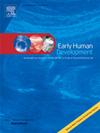有呼吸暂停的早产儿脑干听觉通路的成熟延迟
IF 2
3区 医学
Q2 OBSTETRICS & GYNECOLOGY
引用次数: 0
摘要
目的评估经后年龄(PMA) 33-34周早产儿(AOP)脑干听觉通路的成熟状态,PMA是大多数情况下AOP解决的重要时间标志。研究设计比较有AOP的早产儿和没有AOP的早产儿(非AOP)在相同PMA 33-34周的脑干听觉成熟,以确定差异。结果与非AOP组相比,AOP组的III波和V波潜伏期明显延长(p <;0.05和0.01)。AOP组的I-V间隔明显长于非AOP组(p <;0.001)。I-III和III-V音程也是如此(p <;0.001和0.05)。第三波振幅明显减小(p <;0.05),波V振幅比非aop组略小。在PMA 33周时,AOP组的III、V波潜伏期和所有间隔均明显长于非AOP组(p <;0.05 - -0.001)。在PMA 34周时,AOP组的这些波潜伏期和间隔仍然明显长于非AOP组(p <;0.05 - -0.01)。在PMA 33和34周时,AOP组的第三波振幅明显较小(p <;0.05和0.05)。结论AOP婴儿的脑干听觉成熟在孕33周时延迟,在孕34周时仍延迟。这些发现强调了在PMA 33-34周对AOP婴儿进行监测和适当干预策略的重要性。本文章由计算机程序翻译,如有差异,请以英文原文为准。
Maturational delay in the brainstem auditory pathway of very preterm babies with apnoea
Aims
To assess the maturational status of the brainstem auditory pathway in babies with apnoea of prematurity (AOP) at 33–34 weeks of postmenstrual age (PMA), an important time landmark at which AOP is resolved in most cases.
Study design
Compare brainstem auditory maturation between very preterm babies with AOP and those without AOP (non-AOP) at the same PMA 33–34 weeks to define differences.
Results
The AOP group showed significantly longer latencies of waves III and V latency than the non-AOP group (p < 0.05 and 0.01). The I-V interval in the AOP group was significantly longer than in the non-AOP group (p < 0.001). The same was true for the I-III and III-V intervals (p < 0.001 and 0.05). Wave III amplitude was significantly smaller (p < 0.05), and wave V amplitude was moderately smaller than in the non-AOP. At PMA 33 weeks, waves III and V latencies and all intervals in the AOP group were significantly longer than in the non-AOP group (p < 0.05–0.001). At PMA 34 weeks, these wave latencies and intervals in the AOP group were still significantly longer than in the non-AOP group (p < 0.05–0.01). Wave III amplitude in the AOP group was significantly smaller at both PMA 33 and 34 weeks (p < 0.05 and 0.05).
Conclusions
Brainstem auditory maturation in AOP babies is delayed at PMA 33 weeks, and remains delayed at PMA 34 weeks. These findings highlight the importance of monitoring and adequate intervention strategies during PMA 33–34 weeks in AOP babies.
求助全文
通过发布文献求助,成功后即可免费获取论文全文。
去求助
来源期刊

Early human development
医学-妇产科学
CiteScore
4.40
自引率
4.00%
发文量
100
审稿时长
46 days
期刊介绍:
Established as an authoritative, highly cited voice on early human development, Early Human Development provides a unique opportunity for researchers and clinicians to bridge the communication gap between disciplines. Creating a forum for the productive exchange of ideas concerning early human growth and development, the journal publishes original research and clinical papers with particular emphasis on the continuum between fetal life and the perinatal period; aspects of postnatal growth influenced by early events; and the safeguarding of the quality of human survival.
The first comprehensive and interdisciplinary journal in this area of growing importance, Early Human Development offers pertinent contributions to the following subject areas:
Fetology; perinatology; pediatrics; growth and development; obstetrics; reproduction and fertility; epidemiology; behavioural sciences; nutrition and metabolism; teratology; neurology; brain biology; developmental psychology and screening.
 求助内容:
求助内容: 应助结果提醒方式:
应助结果提醒方式:


